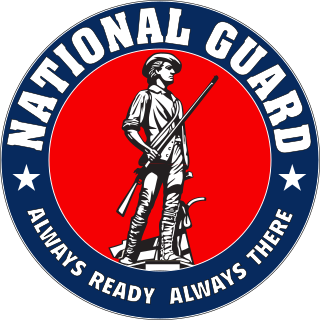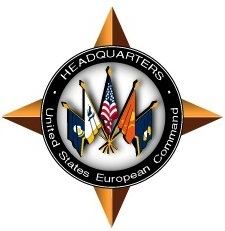
The Army of the Republic of North Macedonia is the military of North Macedonia. The army is organized, prepared and trained to conduct armed struggle and combat and other actions to achieve its constitutional function of defending the independence and territorial integrity of North Macedonia. The army consists of the ground forces and the air force, which are further divided into branches and services. The army has a permanent composition and reserve forces. Since 2005, it is a fully professional defense force compatible with NATO standards. On 27 March 2020, North Macedonia joined NATO as the 30th member.

The Mutual Defense Assistance Act was a United States Act of Congress signed by President Harry S. Truman on 6 October 1949. For U.S. foreign policy, it was the first U.S. military foreign aid legislation of the Cold War era, and initially to Europe. The Act followed Truman's signing of the Economic Cooperation Act, on April 3, 1948, which provided non-military, economic reconstruction and development aid to Europe.

The United States Transportation Command (USTRANSCOM) is one of the eleven unified commands of the United States Department of Defense. In both times of peace and war, USTRANSCOM's role is to provide the Department of Defense with air, land, and sea transportation. USTRANSCOM was founded in 1987 and is based at Scott Air Force Base in Illinois.

The Defense Logistics Agency (DLA) is a combat support agency in the United States Department of Defense (DoD), with more than 26,000 civilian and military personnel throughout the world. Located in 48 states and 28 countries, DLA provides supplies to the military services and supports their acquisition of weapons, fuel, repair parts, and other materials. The agency also disposes of excess or unusable equipment through various programs.
A United States defense standard, often called a military standard, "MIL-STD", "MIL-SPEC", or (informally) "MilSpecs", is used to help achieve standardization objectives by the U.S. Department of Defense.

Military logistics is the discipline of planning and carrying out the movement, supply, and maintenance of military forces. In its most comprehensive sense, it is those aspects or military operations that deal with:

Major non-NATO ally (MNNA) is a designation given by the United States government to countries that have strategic working relationships with the U.S. Armed Forces while not being members of the North Atlantic Treaty Organization (NATO). While the status does not automatically constitute a mutual defense pact with the United States, it does confer a variety of military and financial advantages that are otherwise unobtainable by non-NATO countries. There are currently 19 major non-NATO allies across four continents: 11 in Asia, 3 in Africa, 3 in South America, and 2 in Oceania.

The State Partnership Program (SPP) is a joint program of the United States Department of Defense (DoD) and the individual states, territories, and District of Columbia. The program and the concept originated in 1993 as a simplified form of the previously established (1992) Joint Contact Team Program (JCTP). The JCTP aimed at assisting former Warsaw Pact and Soviet Union Republics, now independent, to form democracies and defense forces of their own. It featured long-term presence of extensive and expensive teams of advisory specialists. The SPP shortened the advisory presence to a United States National Guard unit of a designated state, called a partner, which would conduct joint exercises with the host. It is cheaper, has a lesser American presence, and can comprise contacts with civilian agencies. Today both programs are funded.
Military supply-chain management is a cross-functional approach to procuring, producing and delivering products and services for military materiel applications. Military supply chain management includes sub-suppliers, suppliers, internal information and funds flow.

The Marine Corps Systems Command (MCSC) is the acquisition command of the United States Marine Corps, made up of Marines, sailors, civilians and contractors. As the only systems command in the Marine Corps, MCSC serves as Head of Contracting Authority and exercises technical authority for all Marine Corps ground weapon and information technology programs. MCSC is headquartered at Marine Corps Base Quantico.

The Combined Security Transition Command – Afghanistan was a multinational, U.S. led, military organization during the War in Afghanistan.

The Military Surface Deployment and Distribution Command (SDDC) is the Army Service Component Command of the U.S. Transportation Command (USTRANSCOM) and is a major subordinate command to Army Materiel Command (AMC). This relationship links USTRANSCOM's Joint Deployment and Distribution Enterprise and AMC's Materiel Enterprise. The command also partners with the commercial transportation industry as the coordinating link between DOD surface transportation requirements and the capability industry provides.

The United States Army Security Assistance Command (USASAC) – "the 'Army's Face to the World'" - implements security assistance programs, including Foreign Military Sales (FMS) of defense articles and services to eligible foreign governments. In addition, USASAC is responsible for the US Army's security assistance information management and financial policy and provides logistics guidance to the army's security assistance community. The command also supports the U.S. government's emergency assistance, humanitarian relief, and Operations Other Than War, including peacekeeping operations by the United Nations. The USASAC traces its origins to the Army's technical service era, and was designated a major subordinate command (MSC) of the U.S. Army Materiel Command (AMC) in 1975. Since its formation, USASAC has supported major US military operations and supported international peacekeeping and humanitarian efforts. The USASAC's motto is "Strength in Cooperation."

Military acquisition or defense acquisition is the "bureaucratic management and procurement process", dealing with a nation's investments in the technologies, programs, and product support necessary to achieve its national security strategy and support its armed forces. Its objective is to acquire products that satisfy specified needs and provide measurable improvement to mission capability at a fair and reasonable price.

Mae E. De Vincentis is a former United States Department of Defense official and the vice director for the Defense Logistics Agency (DLA) since August 2010. DLA is a U.S. Department of Defense (DOD)’s combat logistics support agency, providing logistics to the military departments and the Unified Combatant Commands. De Vincentis was the agency's second in command until retiring from the DLA in 2012 and subsequently founding the DLA Foundation.

Logistics operations by NATO forces during the War in Afghanistan (2001–2021) took place under the auspices of the International Security Assistance Force from 2001 to 2014, then under the Resolute Support Mission from 2015 until 2021.

The United States European Command State Partnership Program, according to its own mission, is a National Guard program that "links U.S. states with designated partner countries to ... support the command’s security cooperation objectives." Currently, 22 Partnerships exist "with former Soviet, Yugoslav and Warsaw Pact countries in the EUCOM Area of Responsibility." Becoming independent on the dissolution of the Soviet Union on December 26, 1991, these countries shortly requested the advice and assistance of the United States in creating new self-defense forces.
Initiated in 2013 by the 38th Chief of Staff of the United States Army, Raymond T. Odierno, regionally aligned forces (RAF) provide combatant commands (CCMDs), scalable and tailorable Army capabilities for all requirements, including operational missions, bilateral and multilateral military exercises and security cooperation activities. Army regional alignment is an organizing principle that improves the Army's ability to provide units and capabilities. Regional alignment provides focus and direction for unit training and preparation. RAFs are drawn from the Army Total Force, which includes active United States Army, the Army National Guard and the United States Army Reserve. Corps and divisions are aligned to ensure joint task force capability to every geographic combatant command (GCC). Through regional alignment, the Army maintains its war-fighting skills and complements these skills with language, regional expertise and cultural awareness training.

North Atlantic Treaty Organization—Pakistan relations are the military–to–military relations between Pakistan and the comprised 31-states military alliance, called NATO.

Soviet Nuclear Threat Reduction Act of 1991, 22 U.S.C. § 2551, was chartered to amend the Arms Export Control Act enacting the transfer of Soviet military armaments and ordnances to NATO marking the conclusion of the Cold War. The Act sanctions the Soviet nuclear arsenal displacement shall be in conjunction with the implementation of the Treaty on Conventional Armed Forces in Europe. It funds the Nunn–Lugar Cooperative Threat Reduction program.
















